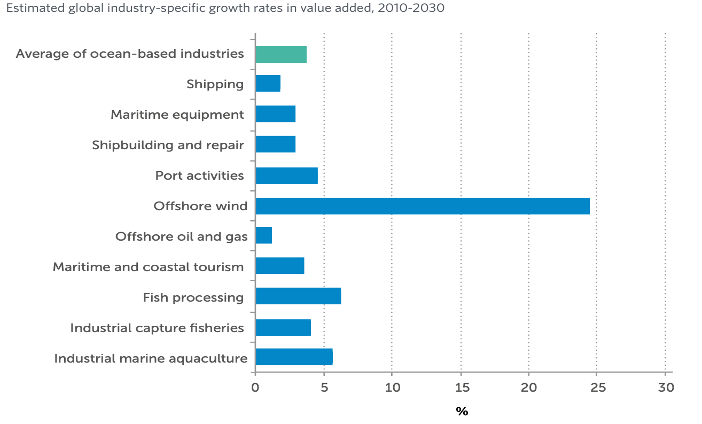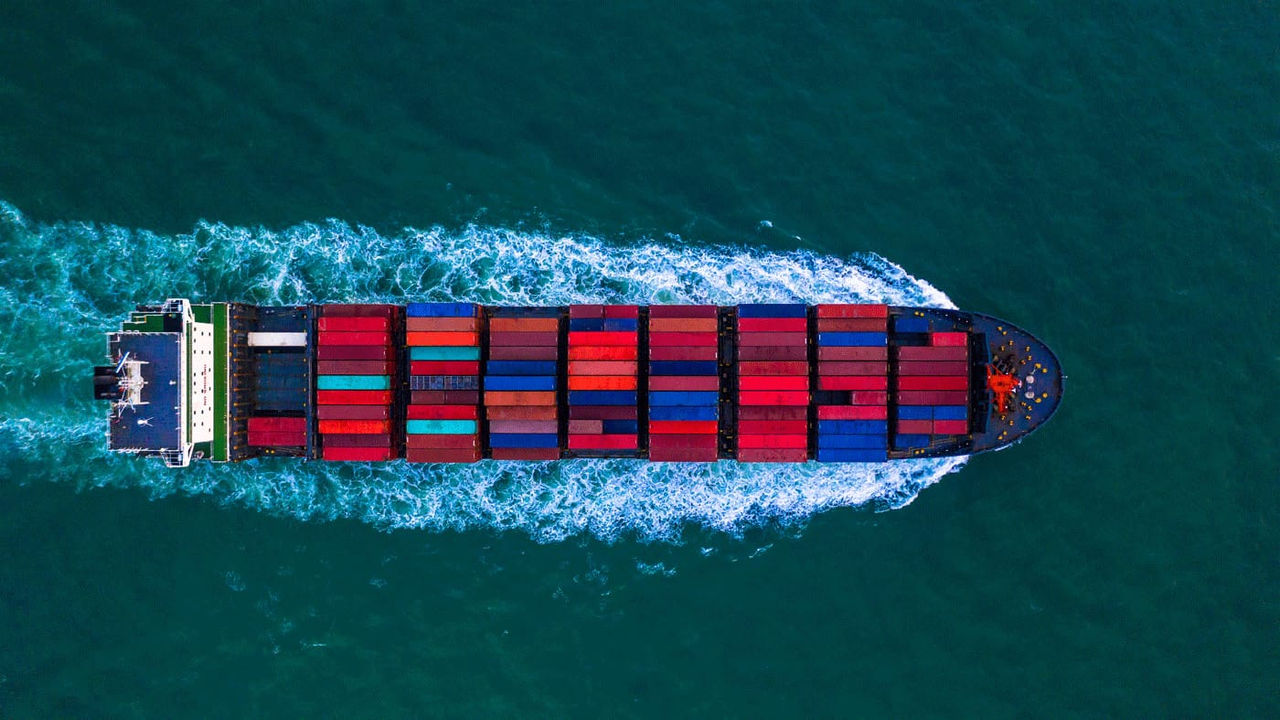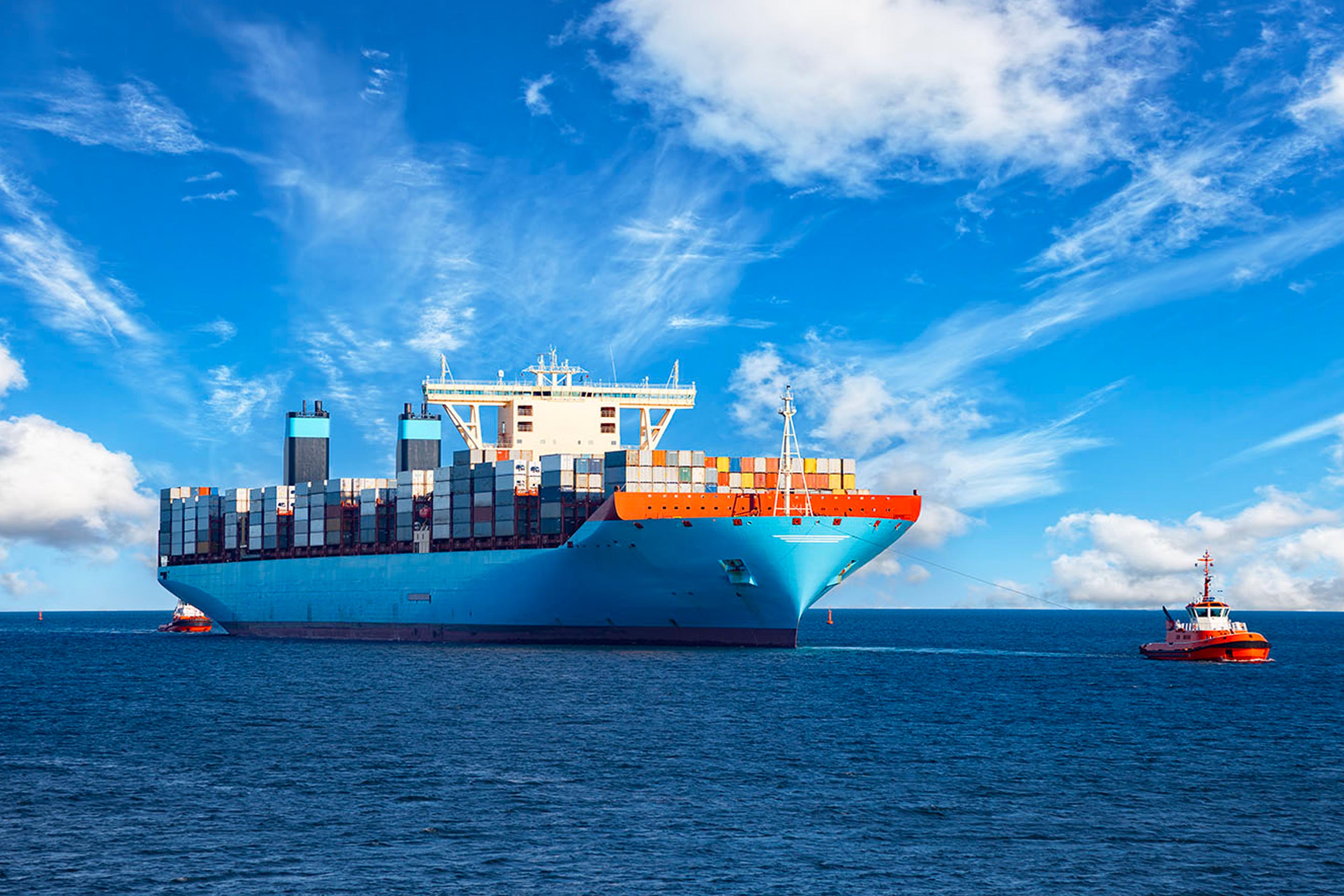Oceans and seas cover more than 70% of the earth’s surface. They support life, help regulate the climate, and underpin industries such as shipping, tourism and fishing which are important around the world. We know that the ocean is an invaluable resource we must use – for example, UN Global Compact figures highlight that ocean shipping moves about 90% of the world’s goods. Without the ocean, global shipping would be almost impossible.
But there’s a balance to be struck if we want to keep using it. The International Maritime Organization (IMO) has announced targets to reduce the overall greenhouse gas emissions from international shipping by 50% by 2050 (compared to 2008). The goal is to increase global trade capabilities but with a smaller environmental impact.
Shipping is by far the least emitting mode of transport within the supply chain. It’s considerably greener per mile than the main alternatives. A large shipping vessel emits just over 1% of the amount of CO2 per tonne-km ejected by an aircraft, according to Marine Digital. Trains and road trucks are worse too, emitting seven times and 16 times as much CO2 respectively. We’ve explored ‘the real environmental impact of freight shipping’ in another article.
Nonetheless, decarbonizing shipping supply chains has a big role in a sustainable future for global trade. There are, of course, goals suitable for the shorter term and longer-term ambitions. The average vessel has a life cycle of 25 years or more, so it makes greater sense to focus on things like optimal engine performance in the short term. Implementing any major engine upgrade is a huge undertaking on ships, typically involving multiple stakeholders.
But that hasn’t stopped the shipping industry from embracing greener approaches. For example, tanker operator Odfjell issued the first ‘green finance’ instrument from a shipping company. The environmental goals (to which the bond’s performance is linked), surpass the industry’s own targets. Its aim is to reduce the carbon intensity of its controlled fleet by 50% by 2030 compared to the 2008 level.
The path to decarbonization for the whole shipping industry will require intensive action from all shipowners and industry players. The greener approaches discussed here – including reducing engine power, exploring fuel alternatives and optimising engines – are critical and essential steps.
The importance of ocean stewardship
In a UN Global Compact report, titled Ocean Stewardship 2030, targeted at ocean-related industries and policymakers, Peter Thomson, the UN Secretary-General’s Special Envoy for the Ocean, summarizes the need to care for our blue planet:
« Our lives and our relationship with Planet Earth have become more dependent than ever upon a healthy ocean. Humankind has for thousands of years sought to conquer, exploit and control the ocean, but we have now reached a time when we must establish a relationship with it that is based upon respect, balance and a sense of stewardship for the common good. »
Peter Thomson
Ocean stewardship refers to the acknowledgement that it’s our responsibility to care for the ocean and its numerous resources. It’s all about protecting the resilience and productivity of the ocean so that current and future generations can continue to benefit. By encouraging sustainable ocean stewardship techniques, it ensures the benefits of the ocean’s resources and services can continue to be felt for years to come.
After all, as the World Economic Forum (WEF) identifies, one of the reasons why the ocean is so important is it creates millions of jobs. What’s more, The Organisation for Economic Co-operation and Development (OECD) is predicting a “marked acceleration” in the range of economic activities using, relying on or supported by the ocean by 2030. They estimate that the value generally by ocean-based industries could double globally in size from $1.5 trillion in 2010 to $3 trillion in 2030. Several industries will be driving this growth.

How technology is helping
Speeding up the pace of change often relies on technology. The UN Ocean Stewardship Report builds on five “tipping points” initially identified as crucial elements for a healthy and productive ocean. These were outlined as goals:
- Fully traceable sustainable seafood
- Set sail for zero
- Harnessing ocean electricity
- Mapping the ocean
- End waste entering the ocean
Within these goals, there is a huge emphasis on increasing sustainable, science-based ocean solutions. Technology can help deliver innovative ways to tackle the issues we face. For shipping, striking the balance between supporting industry growth and protecting the environment tends to be focused around three main areas:
- Decreasing emissions
- Consuming less energy
- Increasing efficiencies
The ‘set sail for zero’ goal for a healthier ocean requires technological advancements, some of which have already started. This includes innovation in vessel design and engineering and greater access to fossil fuel alternatives. Many lower emission ships are already operating, but more are needed to work towards the ambitious IMO goal.
Of course, harnessing electric power from ocean wind, currents, tides and waves is an interesting possibility. But modern ships built on the foundation of electricity (using batteries and fuel cells) or using hybrid technology only be used efficiently on shorter, predictable routes. Deep sea shipping relies on fuel for greater efficiency.
Raphael Ryse, Senior Expert for Turbocharging and Engine Technology at ABB, explains in an interview that this is because of the efficiency curve over the operating range. Fuel cells have the highest efficiency at low power, but at higher power the efficiency drops. With traditional internal combustion engines used in shipping, it’s the other way around. So, while fuel cells or hybrid technology may be important for certain parts of the marine industry – tugboats, for example, where there’s a need to accelerate quickly and operate for a short time before going back to idle – engines offer higher efficiency at high load, making them “likely to remain the power source of choice for deep-sea shipping,” according to Ryse. That’s why innovative solutions for existing engines and cleaner fuel alternatives are so important.

Digital innovation
Shipping companies are increasingly exploring ways to leverage technology and innovation to not only improve the efficiency and productivity of their operations, but to reduce the impact on the environment too. But, as KPMG explain, the maritime industry is inherently complex so most companies are just at the beginning of their digital journey. The industry’s main focus is efficiencies in operations and reductions in Operational Expenses (OPEX).
KMPG refer to Boston Consulting Group’s (BCG) Shipping Benchmark Initiative, which reveals where opportunities lie for shipping companies. One area they focus on is potential cost savings from digital solutions:
| OPEX category | Existing OPEX | Estimated reduction in OPEX from digital solutions | Examples of digital solutions |
| Fuel and energy management | 46% | ~15% | Route planning Trim optimisation Performance insight |
| Port charges | 21% | ~20% | Port documentation management Intelligence Vessel Traffic Management |
| Insurance | 13% | ~15% | Document handling Automated reporting Procurement solution |
| Repair | 10% | ~20% | Condition monitoring Technical and repair management |
| Personnel | 10% | ~10% | Crew management Crew training |
For the shipping industry, the route to efficiency (and cost savings) runs through digitalization. Digital transformation offers shipping companies the chance to streamline operations, customer experience, and efficiency.
One way to evaluate and optimise fleet engine performance is to use software (like Tekomar Xpert) to compare real world engine performance against a digital twin, ensuring that it is running at its most optimal level.
By taking advantage of technologies and innovation such as real-time tracking data, big data, Internet of Things (IoT), blockchain, Artificial Intelligence (AI), Application Programmable Interfaces (APIs), and online third-party logistics (3PL) integrations, companies can optimise almost any area of operations. There’s a chance to disrupt and redefine this legacy industry, with advances in automation and connectivity playing a key role.
Energy efficiencies
Advancements within the industry can come from market influences, companies themselves, and industry bodies. In November 2020, the IMO proposed a new Energy Efficiency Design Index for Existing Ships (EEXI). From 2023, this regulation means all ships under IMO’s remit will need to have met an energy efficiency reduction level. These levels are determined by vessel segment. Also in 2023, an IMO Carbon Intensity Indicator (CII) will be introduced. This will assess all vessels’ actual annual fuel efficiency performance.
It’s clear that sustainable improvements are on the radar and underperformers will need to act quickly to upgrade their vessels.
Luckily, there are plenty of opportunities to enhance the energy efficiency performance of ships. For example, older ships travelling at slower speeds cuts carbon emissions and you can retrofit renewable rotor technologies to allow ships to connect to grid electricity while in ports. This dramatically reduces local pollution.
Manufacturers are also focusing on the hydrodynamics of ships, improving upon the shape of hulls to allow ships to sail more smoothly and increase speed. Certain types of paint can help with this too. The condition of the hull is essential for fuel efficiency, so using an anti-fouling paint to slow any growth of organisms that attach to the hull can reduce frictional resistance.
The designs of ships are also being tweaked and improved. Maersk introduced higher wheelhouses so that it’s possible to stack and carry more containers, all the while using the same amount of fuel. Along with more efficient propeller designers, the company has been able to reduce CO2 emissions by a massive 41% over the past decade.

Alternative fuels
As part of the IMO’s goal to reduce greenhouse gas emissions from international shipping, they are setting targets to limit the sulfur content in ships’ fuel oil. The 2020 Sulfur Limit required all fuels used in ships contain no more than 0.50 percent sulfur.
Alternative fuel sources are long-term solutions but must be cost-effective and easy enough to implement to make sure there’s widespread adoption. Options include:
- Low-sulfur fuels. There are cleaner alternatives which could substantially lower the harmful emissions from diesel combustion.
- Liquified natural gas (LNG). LNG is one such example. It emits nearly no sulphur oxide (SOx) or particulate matter (PM) emissions, 90% less nitrogen oxide (NOx) and 20-25% less carbon dioxide (CO2), according to industry estimates. When used to replace heavy bunker fuel, it makes a great impact on the environment.
- Marine gas oil (MGO). Although still a fossil fuel, MGO is thoroughly refined, making it a less polluting option than traditional ship fuel. It’s something closer to the diesel used for highway tracks.
- Carbon-neutral hydrogen-based fuels. Its use depends on the engine size and application.
- Although carbon free, at the moment ammonia needs to be converted from natural gas on land. This is less efficient than burning fuels on the ship itself, but may improve over time.
Making the switch from complete reliance on fossil fuels to the use of alternative fuels
will play a huge part when it comes to decarbonization and sustainability within the industry. Engine scrubbers – designed to capture sulfur and fine particulate emissions – also play an important role, making currently operational ships cleaner. Many ships installed scrubber systems ahead of the 2020 Sulfur Limit deadline and Bloomberg NEF estimates some 4,800 vessels will be scrubber-equipped by 2025.
An encouraging outlook
The industry may be working against the clock with the various IMO targets, but there is time to evaluate all the solutions properly. The best ones will, of course, depend on the application. And in most cases the shipping industry will come to different solutions to those most appropriate for land-based applications.
Overall, the use of innovative technologies minimizes risk and maximizes opportunities. Not only do they often seek to reduce the environmental impact on the ocean, but they offer strategic business outcomes. Aligning the goals of boosting economic activity in the ocean with the sustainability of ocean ecosystems is only advantageous.
Growth and sustainably can go hand in hand and generate win-win outcomes when we priorities long-term use. Value can only be extracted from the ocean if we look after it. That’s why a lot of innovation comes from those invested in its future.














